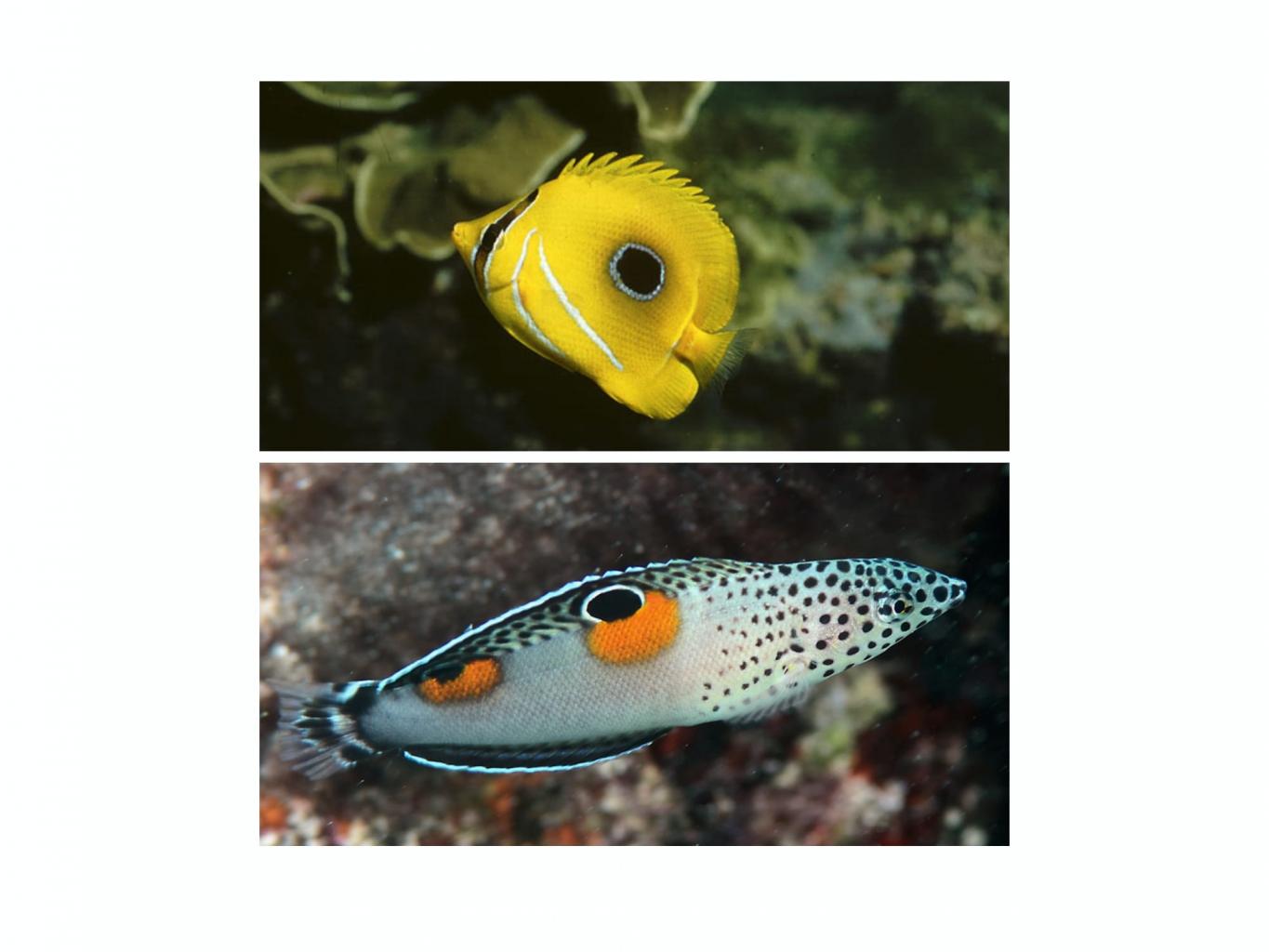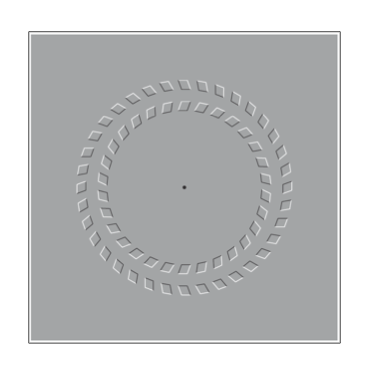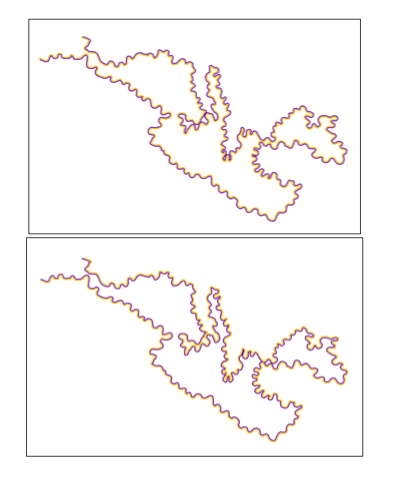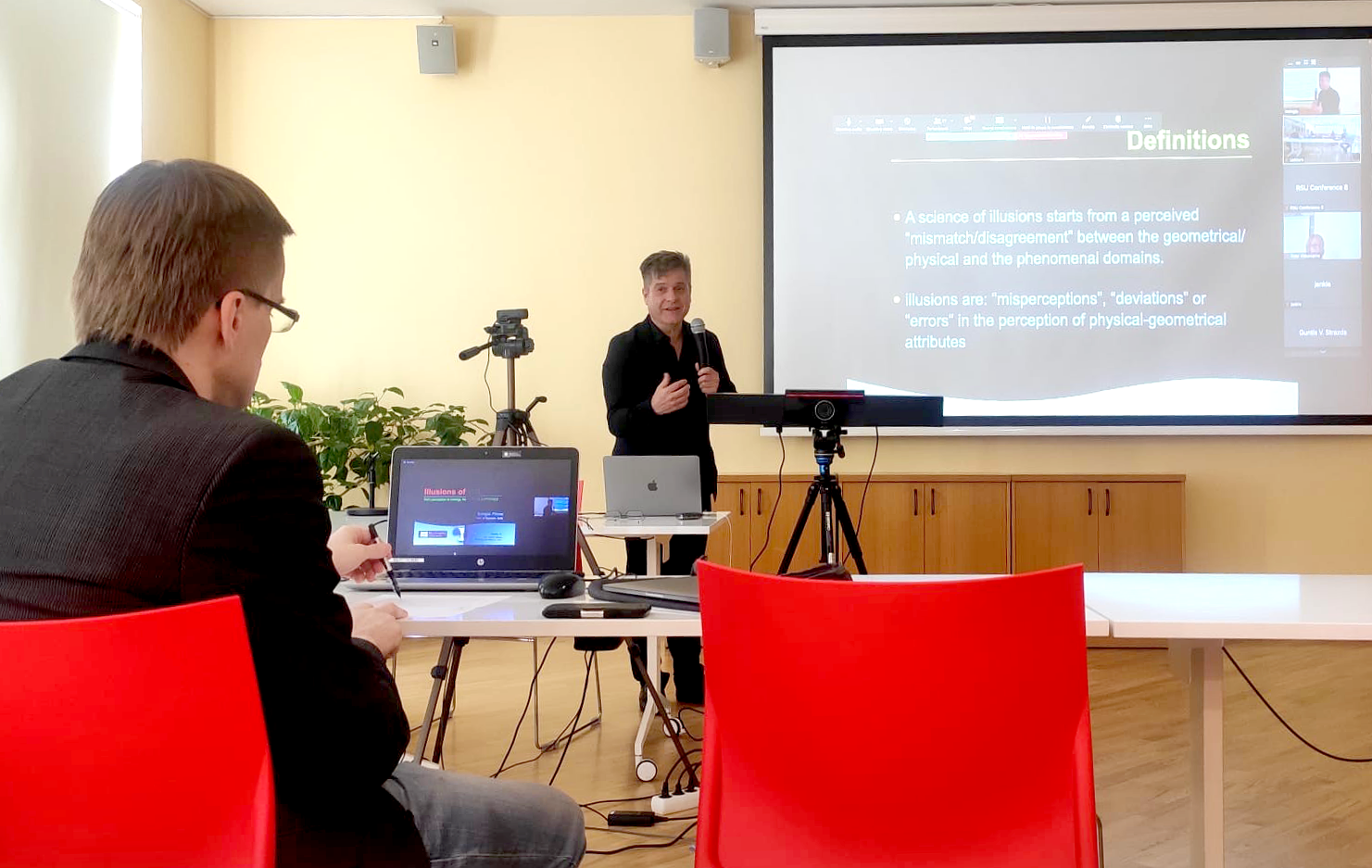Prof. Pinna Looks Back at Webinar on Illusions: Latvian Researchers Show An Incredible Open-Mindedness
Professor Baingio Pinna's webinar “Illusions of mind from perception to biology, from normality to pathology” concluded a series of interdisciplinary cognitive sciences research webinars that has taken place over the last few months at Rīga Stradiņš University (RSU).
Pinna is a Professor of the Department of Biomedical Sciences at the University of Sassari. His main research topics are visual perception, more specifically perceptual organisation and visual illusions.
Prof. Jurģis Šķilters is a cognitive scientist who also does work on visual perception. He is a professor at the Faculty of Computing and the Chair of the Laboratory for Perceptual and Cognitive Systems at the University of Latvia (LU). Prof. Šķilters established the first Cognitive Science research and academic centre in the Baltics and is the organiser of the series.

Professors Šķilters (left) and Pinna
Tell me about the series of webinars that concluded with Prof. Pinna's webinar on 16 June.
Prof. Šķilters: The overall idea for this series was to show how useful cognitive sciences can be for different fields, primarily (but not only) for medical sciences. I wanted to show how different research perspectives and fields can be incorporated in an interdisciplinary way. The series included very different topics and perspectives, like artificial intelligence, sensor technologies, neuroscience and other areas. Speakers included leading researchers from Europe and US studying spatial cognition and spatial neuroscience, non-verbal communication, and sensor technologies. We wanted to show that cognitive sciences are a vibrant and productive way of integrating different perspectives.
The important thing is that we collaborate with researchers at RSU without thinking of what discipline someone is working in.
We're trying to emphasise that we should focus on problems instead of just working within the borders of our different fields. Who cares about disciplinary borders? It's 2022!
COVID-19 research is a good example where instead of drawing borders, researchers are successfully focusing on finding solutions to a common problem.
Was there anyone from a field that you were surprised at seeing at the series?
Prof. Pinna: We have started collaborating with the field of radiology and yesterday after the webinar, we talked to a neurologist for the entire afternoon about how to use different kinds of visual effects and how useful they could be. This was really surprising to me, because neurologists and psychologists can often disagree and argue, but not in this case. I also met a mathematician with whom we were talking about how to make a computational model from an illusion.
Prof. Šķilters: There were also some people from the humanities who attended the webinars. I think there were some philosophers and some artists. I remember that someone asked a very deep philosophical question in one of the first webinars!
What was your webinar about?
Prof. Pinna: I had two webinars: the first was on face perception, and the second was on visual illusions.
Visual illusions are usually considered to be errors, or curiosities that attract people. They are almost seen like magic, something that creates wonder and astonishment. I tried to demonstrate that this is not true. Visual illusions are everywhere and occur naturally in nature. Animals use illusions to deceive, for example: prey deceive predators, and predators deceive prey.

Not even speaking of the use of visual illusions in courtship and mating rituals. Animals use them to compete, to be seen and perceived, or to hide something. Human lives and interactions are full of many kinds of illusions as well. In general, all human life is based on illusions. We use illusions to show the best, to deceive, or to attract. This ecological aspect of illusions has never been considered very deeply but illusions are the basic component of biology and of social, human life.
There's often judgement attached, like people are faking or trying to make something look better than it is, but you're saying it's normal.
Prof. Pinna: Yes. We know that people sometimes deceive. For example if you have a romantic meeting with a person, you and your partner will both prepare to show off your best sides for the meeting. You both know that it is an illusion and we use this not as a way to deceive, but rather as something real and necessary for creating the best conditions and the best situation. A predator knows that their prey is trying to deceive them. A gazelle jumps to show that it is fresh and can escape, but predators and prey interact despite knowing that it is a clear illusion. They can accept these conditions.
Can you speak more about the feedback you've gotten about the series?
Prof. Šķilters: The best thing to hear was that people from different fields - medical, psychological, or biological - interacted with the subject and found that it was something that they had not previously considered as being important, but came to realise that it matters to their field. I think that a large part of the audience benefitted by seeing some familiar phenomenon from an entirely different angle.
Prof. Pinna: I can tell you my impression as a foreign scientist here in Riga. I noticed that attendees to these webinars were very open and came from different fields without thinking about boundaries, which was unusual. Very unusual.
I haven't seen this in other countries. This was my second webinar here, and I'm very happy because I had a good and fruitful dialogue with people. They asked questions based on their field because they truly wanted to understand or because they were having doubts. Doubts can induce new questions and create new research. It is always very productive for me to come to Latvia. What I saw here is incredible open mindedness. This is wonderful to me.
Prof. Šķilters: This is what I wanted to say too. The good thing about cognitive science, and the research on perception in particular, is that it is a format for putting together different minds and integrating different perspectives. For instance, researching illusions could be very important for detecting neurodegenerative diseases early. This is one of the directions that Prof. Pinna and my peers here at RSU and in my lab at LU are working on.
Explain how this might work.
Prof. Šķilters: If a patient is starting to show epileptic symptoms, it might be possible to diagnose them very early by looking at their responses to certain horizontal-vertical visuo-spatial stimuli. There are balance illusions that can have a very strong impact on the vestibular system. Hypothetically, a person with epileptic symptoms could react to an illusion very differently than others. One of the illusions that Prof. Pinna discovered over 10 years ago, the rotation illusion, is being used as medical evidence in diagnosing schizophrenia.

Illusion of apparent rotation (Pinna Illusion)
By keeping your gaze fixed on the black spot at the centre of the figure and by moving your head back and forth one can perceive an illusory movement: the two rings made of lozenges rotate in opposite directions, one clockwise, and the other anti-clockwise.
If you test people with eye tracking tools, you can see that schizophrenia patients can perceive the rotating effect faster than others. This is great, because you don't have to put them through unpleasant questioning, you don't have to make them suffer.
Patients can have problems talking, especially thinking about neurodegenerative diseases like Parkinson's and Alzheimer's, but using illusions as a diagnostic tool could be ground-breaking - a human-friendly way of diagnosing early stages of neurodegenerative diseases.
How does one invent an illusion?
Prof. Pinna: If I have an idea of the way our brains work, then I can also create a trick on the basis of my ideas of perceptual organisation. Illusions are not something you dream up during the night, or that come as inspiration from above. Rather, they are good tools for proving your theories.
Imagine a fisherman, if they understand how the fish mind works, then they can figure out how to catch fish. You can create the right net in the right way that will catch them. We are like fishermen trying to catch the way the mysterious mind works, the complexity of our brain. Illusions are tools like what fishermen use to catch fish.
Can you describe the watercolour illusion? What are we looking at?
Prof. Pinna: There was another very famous illusion known as neon colour spreading. In this illusion there is a black line that stops and continues in another colour, for example purple, or red. This creates a kind of transparency effect where it looks like a kind of light is shining, like neon. Stephen Grossberg developed a model explaining that in our brain, the black line inhibits the other colour, which is weaker. This causes the weaker colour's boundaries to be broken and for it to spread everywhere. I was in disagreement with his idea. In my opinion, this would also work if instead of one line continuing on from another, you draw a line in parallel to the first. This would cause that same kind of inhibition, but even stronger.

You can create the illusion with just two magic markers! I took purple and made an irregular shape, then juxtaposed it with an orange contour and got the colour spread! The orange colour spreads to fill an entire surface. I participated in a conference and my work was accepted as a poster presentation. A poster is a huge piece of paper on which you usually explain stimuli, procedure, methods, drafts and so on, but I decided to only draw this illusion with two magic markers. I wrote the title “The Watercolour Illusion” and my name. That was it. It became very famous and attracted a lot of attention. It was made without any complicated tools.
Prof. Šķilters: It's funny to think of the impact that the illusion had! When you look at the papers, it's incredible! It's among the papers that has had the highest impact in the field of visual illusions in general. I didn't know the story of the poster!
Prof. Pinna: It's true!
Scientists came up to talk to me and asked “What happens if you change the colours?” and I just took my markers and said “I'll show you immediately,” and drew a new shape. This is an invitation for everyone that you don't need to have incredible technologies. What is important is to have an idea.
The other trick for discovering an illusion is to think in a different way. Try to change something in a way that nobody has tried before. In many conferences, 90% of the talks and works are very similar. Imagine a lamp and that everyone is looking in the same illuminated area. Instead, it can be useful to look where it is dark. You have many more possibilities to find something interesting.
How long have you collaborated with one another?
Prof. Šķilters: Baingio and I have known each other for about 12 years. We share core research interests and have worked on several research questions together. I knew that it would be very inspirational to invite a top researcher who could show a very lively and productive angle to exploring science. I admire that Baingio's work is creative and at the same time productive. Even if you are a good researcher, you're not always both.
Prof. Pinna: I value my collaboration with Jurģis too! He always tries to contradict me, and create doubts. Not to fight, but rather to help me understand things better. There can sometimes be envy among scientists, but this is not the case in our collaboration and friendship.
Prof. Šķilters: It is very important for science that we can discuss ideas without agreeing 100%. Actually, we frequently have very different opinions.
This is something that I'd be happy to see more of in Latvian research. People think that it's bad to have different or conflicting opinions, but it's not!
How are you both connected to RSU?
Prof. Šķilters: It's very simple. My lab has an interest in neuroscience and in medical, clinical topics, so of course we have collaborators at RSU. The point is that RSU is our neighbouring university and it is only natural for me that if you want to work with neuroscience, or do radiological research on the human brain, that you collaborate with RSU. My lab is very open in that respect, so this was a very natural way of collaborating and interacting.
Prof. Pinna: I've collaborated with the Department of Physics, Mathematics, and Optometry, and the Department of Psychology at LU together with Jurģis' department in the past. I've come here several times and it's always very productive. I think my first visiting professorship in Riga was at the Stockholm School of Economics.
If there is an interesting initiative, then it doesn't matter what institute it comes from.

Prof. Pinna during his webinar at Rīga Stradiņš University
Related news
 Sustainable ideas and an innovation bootcamp in Vienna – RSU students invited to apply for the Green Hexagon programmeRSU Alumni, For RSU Employees, For Students, Innovation
Sustainable ideas and an innovation bootcamp in Vienna – RSU students invited to apply for the Green Hexagon programmeRSU Alumni, For RSU Employees, For Students, Innovation


